Hydrolysis and Photolysis Kinetics, and Identification of Degradation Products of the Novel Bactericide 2-(4-Fluorobenzyl)-5-(Methylsulfonyl)-1,3,4-Oxadiazole in Water
Abstract
:1. Introduction
2. Materials and Methods
2.1. Chemicals and Reagents
2.2. UPLC Analysis
2.3. UPLC–MS/MS Analysis
2.4. Calibration Curve
2.5. Degradation Kinetics Experiments
2.6. Identification of Degradation Products
3. Results and Discussion
3.1. Hydrolysis Experiments
3.1.1. Effect of pH
3.1.2. Effect of Initial Concentration
3.1.3. Effect of Temperature
3.2. Photolysis Experiments
Effect of Initial Concentration
3.3. Identification of Degradation Product
3.4. Future Research
4. Conclusions
Supplementary Materials
Author Contributions
Funding
Acknowledgements
Conflicts of Interest
References
- Li, P.; Shi, L.; Yang, X.; Yang, L.; Chen, X.W.; Wu, F.; Shi, Q.C.; Xu, W.M.; He, M.; Hu, D.Y.; et al. Design, synthesis, and antibacterial activity against rice bacterial leaf blight and leaf streak of 2,5-substituted-1,3,4-oxadiazole/thiadiazole sulfone derivative. Biloorg. Med. Chem. Lett. 2014, 24, 1677–1680. [Google Scholar] [CrossRef] [PubMed]
- Mason, W.A.; Meloan, C.E. Degradation products of phoxim (Bay 77488) on stored wheat. J. Agric. Food Chem. 1976, 24, 299–304. [Google Scholar] [CrossRef] [PubMed]
- Hoehl, H.U.; Barz, W. Metabolism of the insecticide phoxim in plants and cell suspension cultures of soybean. J. Agric. Food Chem. 1995, 43, 1052–1056. [Google Scholar] [CrossRef]
- Roberts, T.R.; Hutson, D.H.; Lee, P.W.; Nicholls, P.H.; Plimmer, J.R. Metabolic Pathways of Agrochemicals: Insecticides and Fungicides; JSC International: Harrogte, UK, 1999; p. 447. [Google Scholar]
- Dai, K.; Peng, T.Y.; Chen, H.; Liu, J.; Zan, L. Photocatalytic degradation of commercial phoxim over La-doped TiO2 nanparticles in aqueous suspension. Environ. Sci. Technol. 2009, 43, 1540–1545. [Google Scholar] [CrossRef] [PubMed]
- Benzi, M.; Robotti, E.; Gianotti, V. Study on the photodegradation of amidosulfuron in aqueous solutions by LC-MS/MS. Environ. Sci. Pollut. Res. 2013, 20, 9034–9043. [Google Scholar] [CrossRef]
- Guerard, J.J.; Miller, P.L.; Trouts, T.D.; Chin, Y.P. The role of fulvic acid composition in the photosensitized degradation of aquatic contaminants. Aquat. Sci. 2009, 71, 160–169. [Google Scholar] [CrossRef]
- Mao, L.; Meng, C.; Zeng, C.; Ji, Y.F.; Yang, X.; Gao, S.X. The effect of nitrate, bicarbonate and natural organic matter on the degradation of sunscreen agent p–aminobenzoic acid by simulated solar irradiation. Sci. Total Environ. 2011, 409, 5376–5381. [Google Scholar] [CrossRef]
- Fenoll, J.; Sabater, P.; Navarro, G.; Pérez-Lucas, G.; Navarro, S. Photocatalytic transformation of sixteen substituted phenylurea herbicides in aqueous semiconductor suspensions: Intermediates and degradation pathways. J. Hazard. Mater. 2013, 244, 370–379. [Google Scholar] [CrossRef]
- Kearney, P.C.; Muldoon, M.T.; Somich, C.J. UV-Ozonation of eleven major pesticides as a waste disposal pretreatment. Chemosphere 1987, 16, 2321–2330. [Google Scholar] [CrossRef]
- Machado, F.; Collin, L.; Boule, P. Photolysis of bromoxynil (3,5-dibromo-4-hydroxybenzonitrile) in aqueous solution. Pestic. Sci. 1995, 45, 107–110. [Google Scholar] [CrossRef]
- Martins, A.F.; Henriques, D.M.; Wilde, M.L.; Vasconcelos, T.G. Advanced oxidation processes in the treatment of trifluraline effluent. J. Environ. Sci. Health Part B 2006, 41, 245–252. [Google Scholar] [CrossRef] [PubMed]
- Le Person, A.; Mellouki, A.; Munoz, A.; Borras, E.; Martin-Reviejo, M.; Wirtz, K. Trifluralin: Photolysis under sunlight conditions and reaction with HO radicals. Chemosphere 2007, 67, 376–383. [Google Scholar] [CrossRef] [PubMed]
- Ormad, M.P.; Miguel, N.; Claver, A.; Matesanz, J.M.; Ovelleiro, J.L. Pesticides removal in the process of drinking water production. Chemosphere 2008, 71, 97–106. [Google Scholar] [CrossRef] [PubMed]
- Chelme-Ayala, P.; El-Din, M.G.; Smith, D.W. Kinetics and mechanism of the degradation of two pesticides in aqueous solutions by ozonation. Chemosphere 2009, 78, 557–562. [Google Scholar] [CrossRef] [PubMed]
- Wyer, M.; Vanloon, G.W.; Dust, J.M.; Buncel, E. Silver ion binding to the organophosphorus pesticide diazinon and hydrolytic pathways revealed by mass spectrometric and NMR studies. Can. J. Chem. 2015, 93, 1266–1275. [Google Scholar] [CrossRef]
- Zhang, Y.Y.; Hou, Y.X.; Chen, F.; Xiao, Z.Y.; Zhang, J.N.; Hu, X.S. The degradation of chlorpyrifos and diazinon in aqueous solution by ultrasonic irradiation: Effect of parameters and degradation pathway. Chemosphere 2011, 82, 1109–1115. [Google Scholar] [CrossRef] [PubMed]
- Lartiges, S.B.; Garrigues, P.P. Degradation kinetics of organophosphorus and organonitrogen pesticides in different waters under various environmental conditions. Environ. Sci. Technol. 1995, 29, 1246–1254. [Google Scholar] [CrossRef]
- Patil, S.G.; Nicholls, P.H.; Chamberlain, K.; Briggs, G.G.; Bromilow, R.H. Degradation rates in soil of 1-benzyltriazoies and two triazole fungicides. Pest. Manag. Sci. 1988, 22, 333–342. [Google Scholar] [CrossRef]
- Sato, K.; Tanaka, H. Degradation and metabolism of a fungicide, 2, 4, 5, 6-tetra-chloroisophthalonitrile (TPN) in soil. Biol. Fert. Soils 1987, 3, 205–209. [Google Scholar] [CrossRef]
- Ali, M.; Kazmi, A.A.; Ahmed, N. Study on effects of temperature, moisture and pH in degradation and degradation kinetics of aldrin, endosulfan, lindane pesticides during full–scale continuous rotary drum composting. Chemosphere 2014, 102, 68–75. [Google Scholar] [CrossRef]
- Usharani, K.; Kadirvelu, K.; Muthukumar, M. Effect of pH on the degradation of aqueous organophosphate (methylparathion) in wastewater by ozonation. Int. J. Environ. Res. 2012, 6, 557–564. [Google Scholar]
- Koumaki, E.; Mamais, D.; Noutsopoulos, C.; Nika, M.C.; Bletsou, A.A.; Thomaidis, N.S.; Eftaxias, A.; Stratogianni, G. Degradation of emerging contaminants from water under natural sunlight: The effect of season, pH, humic acids and nitrate and identification of photodegradation by-products. Chemosphere 2015, 138, 675–681. [Google Scholar] [CrossRef] [PubMed]
- Xu, Y.L.; Nguyen, T.V.; Reinhard, M.; Gin, K.Y.H. Photodegradation kinetics of p-tert-octylphenol, 4-tert-octylphenoxy-acetic acid. Chemosphere 2011, 85, 790–796. [Google Scholar] [CrossRef] [PubMed]
- Lagunas-Allué, L.; Martínez-Soria, M.T.; Sanz-Asensio, J.; Salvador, A.; Ferronato, C.; Chovelon, J.M. Photocatalytic degradation of boscalid in aqueous titanium dioxide suspension: Identification of intermediates and degradation pathways. Appl. Catal. B: Environ. 2010, 98, 122–131. [Google Scholar] [CrossRef]
- Gao, M.; Yu, L.; Li, P.; Song, X.; Chen, Z.; He, M.; Song, B.A. Label-free quantitative proteomic analysis of inhibition of Xanthomonas axonopodis pv. citri by the novel bactericide Fubianezuofeng. Pestic. Biochem. Phys. 2017, 138, 37–42. [Google Scholar] [CrossRef] [PubMed]
- Linghu, R.; Jin, M.; Pan, S.; Zhang, J.; Tang, M.; He, J.; Hu, D.Y. Determination and Method Validation of the New Sulfone Fungicide 2-(4-Fluorophenyl)-5-Methylsulfonyl-1, 3, 4-Oxadiazole in Tomato and Soil by UPLC in Field Trial Samples from Guizhou Province, China. Bull. Environ. Contam. Toxicol. 2015, 95, 373–378. [Google Scholar] [CrossRef] [PubMed]
- Chai, L.K.; Wong, M.H.; Mohd-Tahir, N.; Hansen, H.C.B. Degradation and mineralization kinetics of acephate in humid tropic soils of Malaysia. Chemosphere 2010, 79, 434–440. [Google Scholar] [CrossRef]
- Wang, H.Z.; Zuo, H.G.; Ding, Y.J.; Miao, S.S.; Jiang, C.; Yang, H. Biotic and abiotic degradation of pesticide Dufulin in soils. Environ. Sci. Pollut. Res. 2014, 21, 4331–4342. [Google Scholar] [CrossRef]
- Gundi, V.A.K.B.; Reddy, B.R. Degradation of monocrotophos in soils. Chemosphere 2006, 62, 396–403. [Google Scholar] [CrossRef]
- Sehgal, C.M.; Wang, S.Y. Threshold intensities and kinetics of sonoreaction of thymine in aqueous solutions at low ultrasonic intensities. J. Am. Chem. Soc. 1981, 103, 6606–6611. [Google Scholar] [CrossRef]
- Adewuyi, Y.G. Sonochemistry: Environmental science and engineering applications. Ind. Eng. Chem. Res. 2001, 40, 4681–4715. [Google Scholar] [CrossRef]
- Mukesh, G.; Hu, H.Q.; Mujumdar, A.S.; Madhmita, B.R. Sonochemical decomposition of volatile and non-volatile organic compounds-a comparative study. Water Res. 2004, 38, 4247–4261. [Google Scholar]
- Yang, K.W.; Mo, H.H.; An, F.C.; Xu, X.B. Method for studying hydrolysis of organic chemicals as a function of pH. Environ. Chem. 1994, 13, 206–209. [Google Scholar]
- Lin, Z.X.; An, C.J.; Liu, Y. Physical Chemistry: Kinetics, Electrochemistry, Surface and Colloid Chemistry; Wuhan University Press: Wuhan, China, 2013. [Google Scholar]
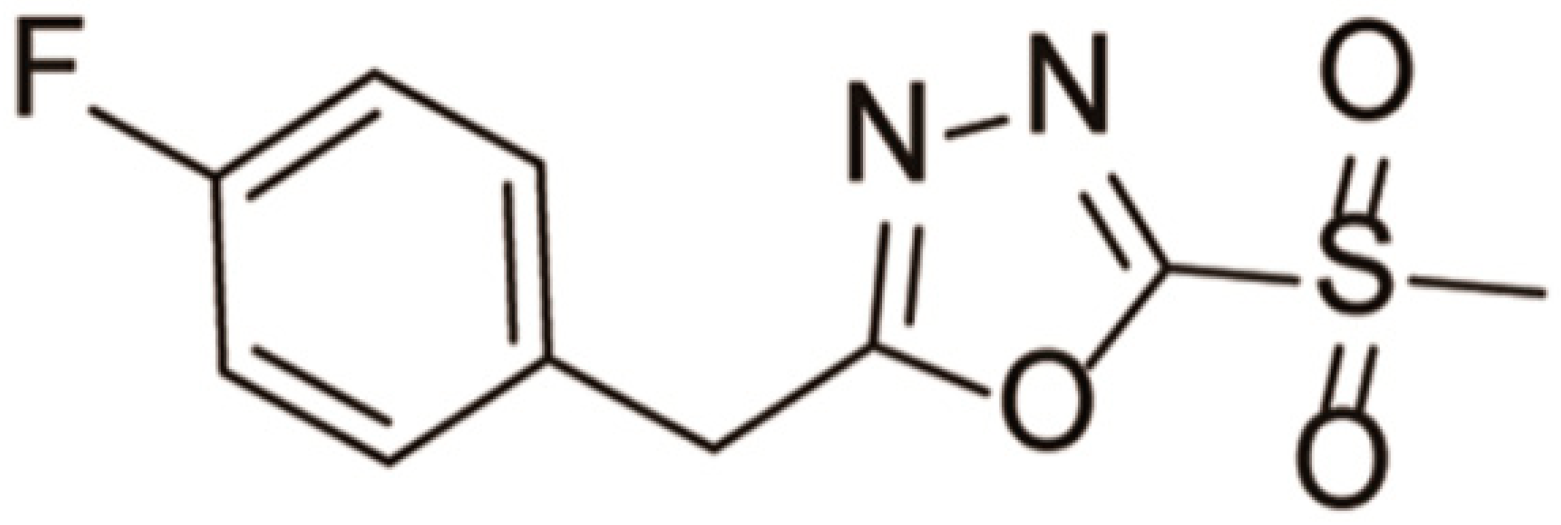
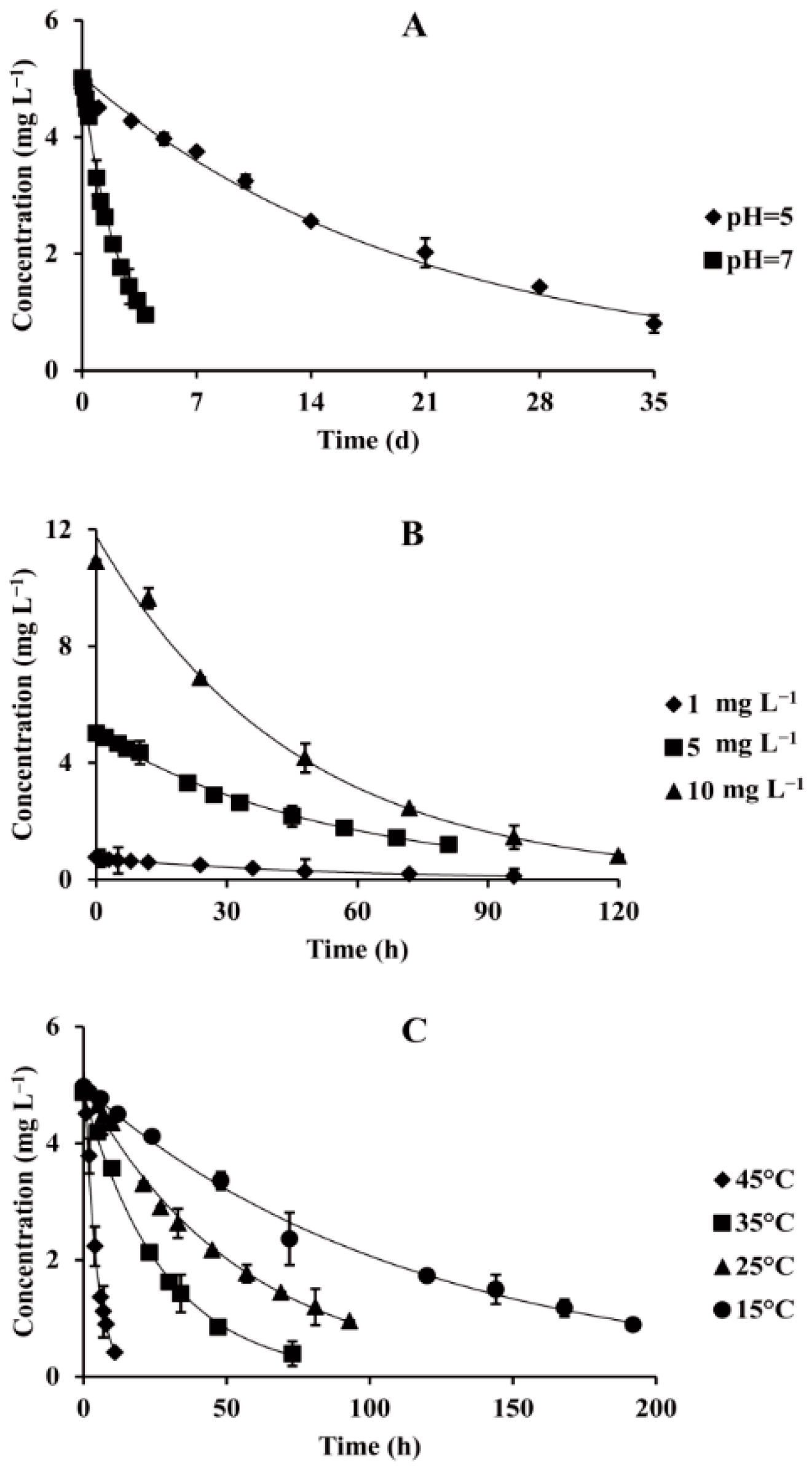
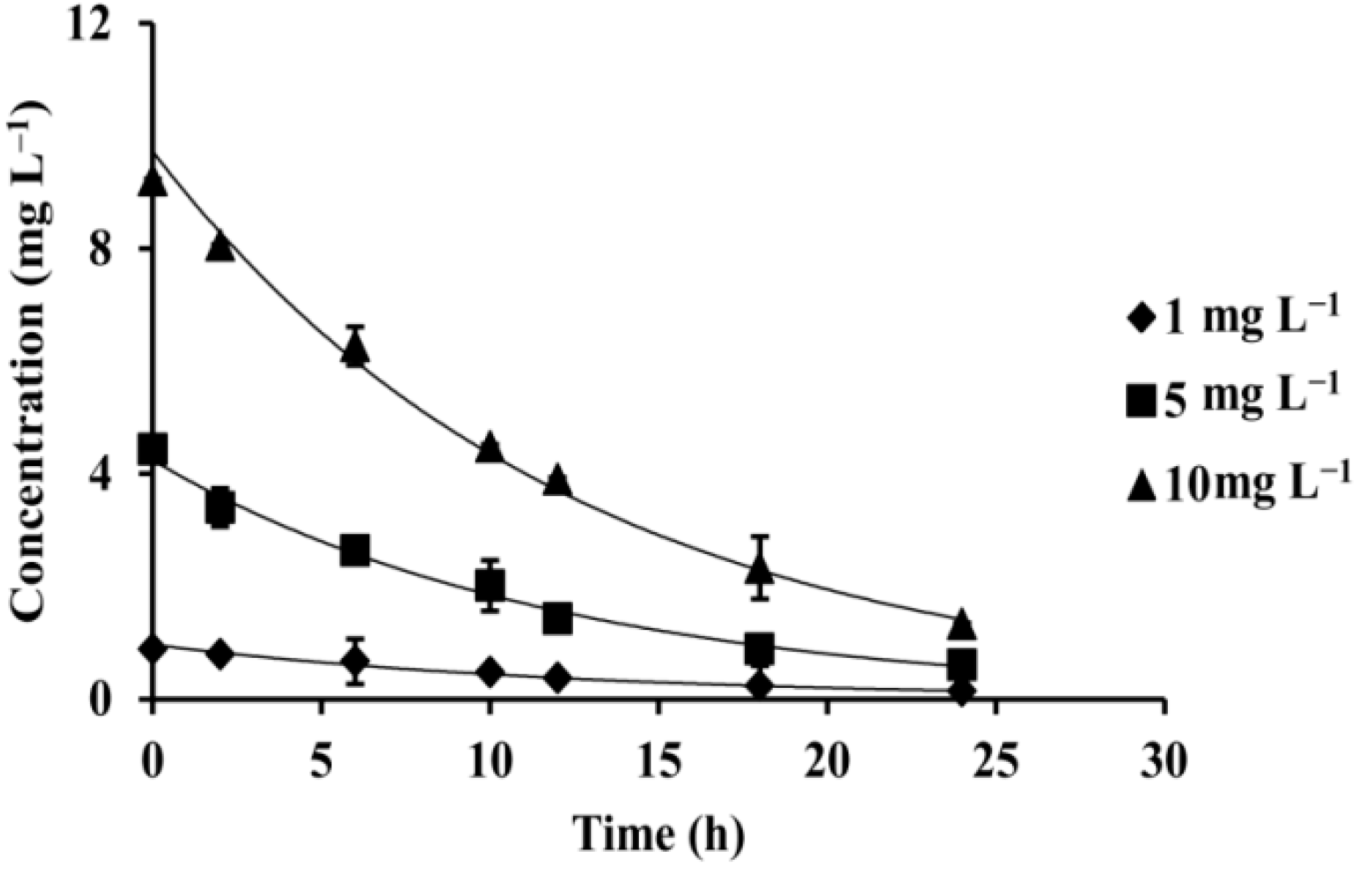
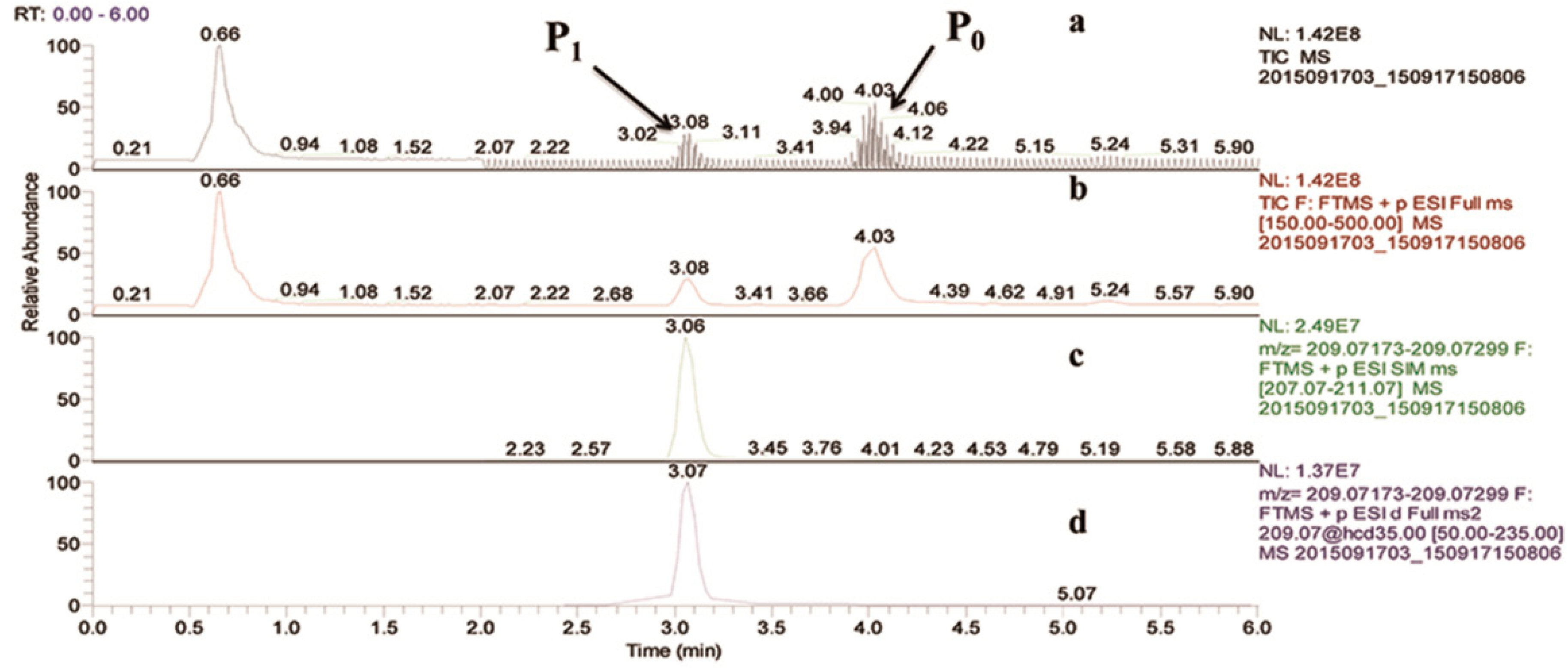
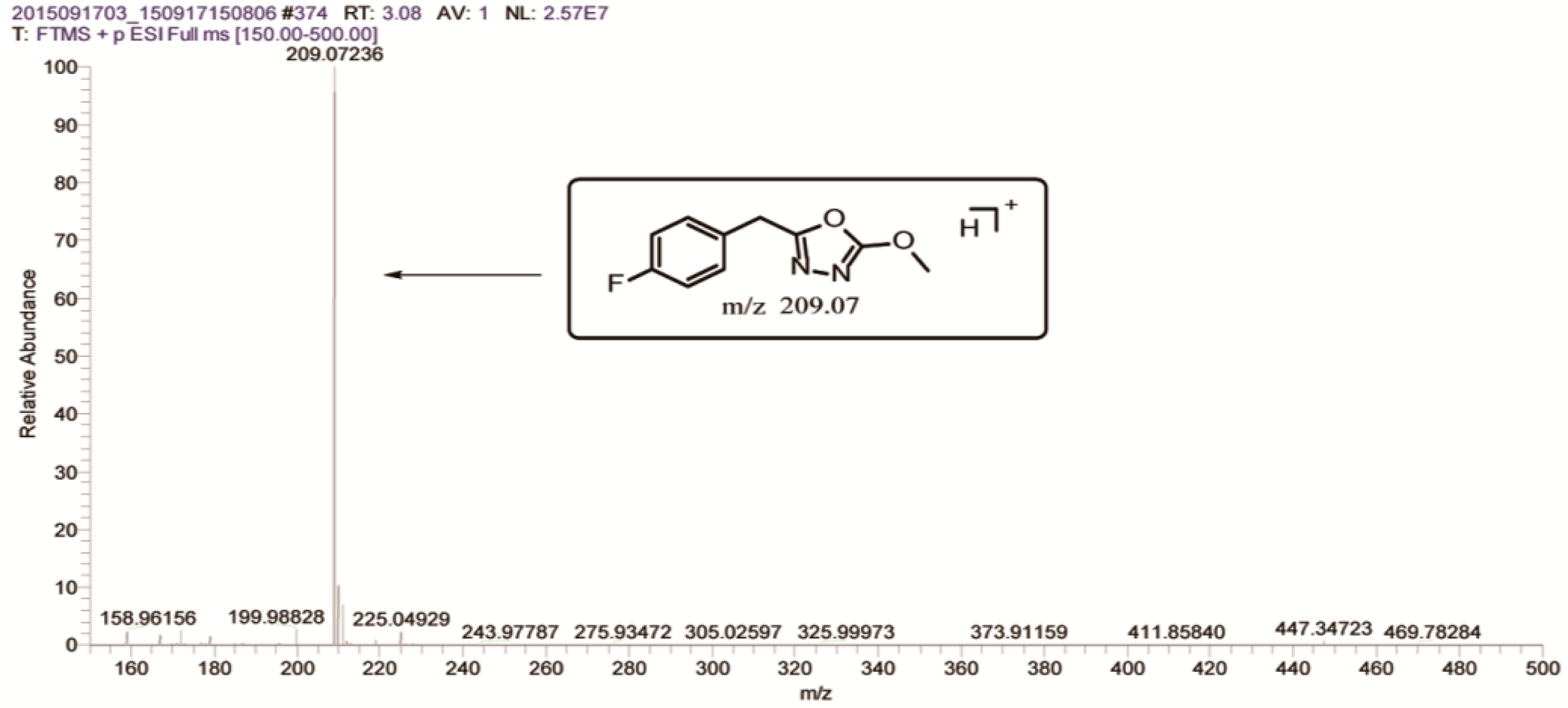
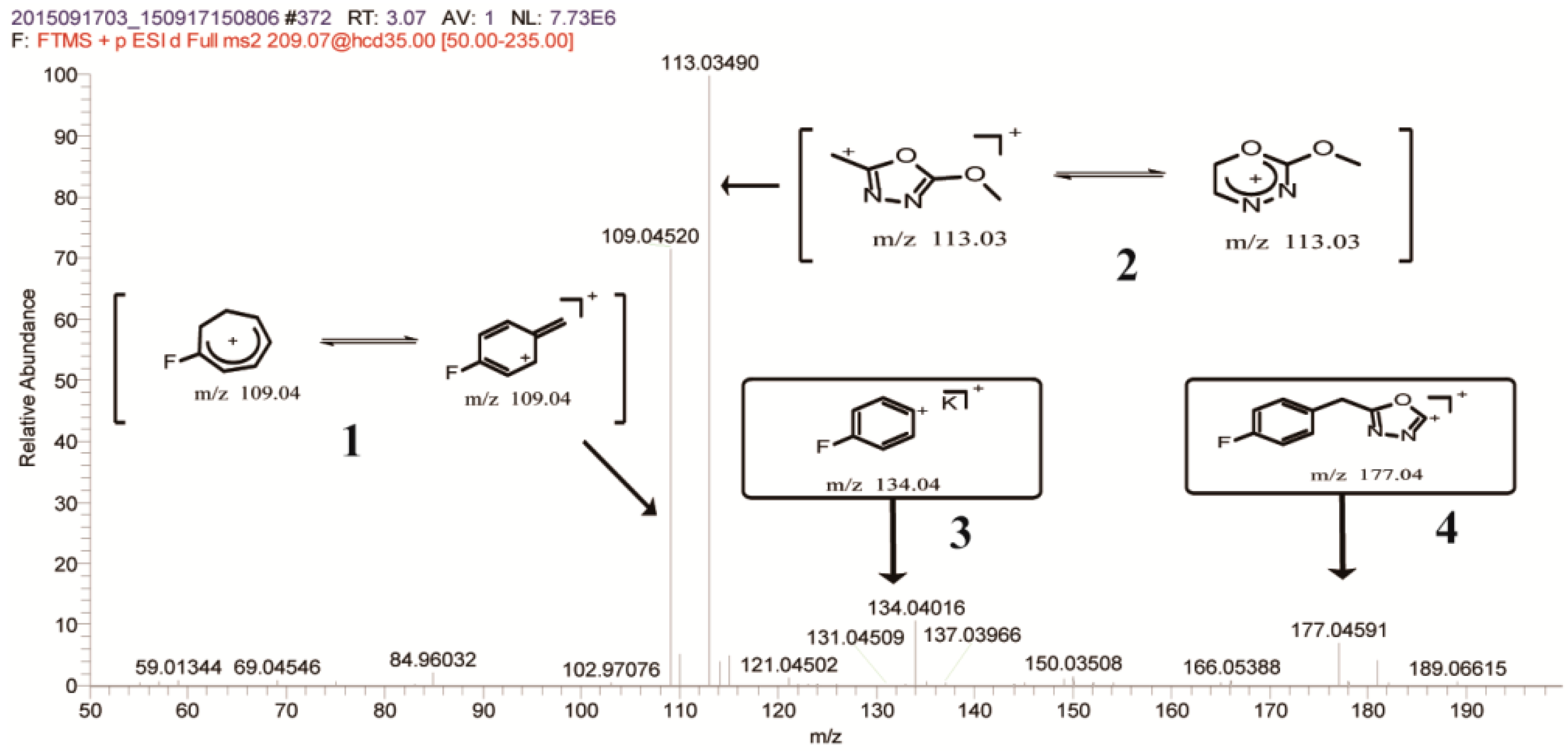
| Kelvin Temperature (K) | 288 | 298 | 308 | 318 | Average |
|---|---|---|---|---|---|
| Rate constant k | 0.009 | 0.018 | 0.035 | 0.231 | / |
| Ea (kJ mol−1) | 50.7 | 50.74 | 50.74 | 47.4 | 49.90 |
| ΔH (kJ mol−1) | 48.31 | 48.27 | 48.18 | 44.76 | 47.38 |
| ΔS (kJ mol−1 *K) | −106.36 | −114.8 | −123.25 | −131.69 | −119.03 |
© 2018 by the authors. Licensee MDPI, Basel, Switzerland. This article is an open access article distributed under the terms and conditions of the Creative Commons Attribution (CC BY) license (http://creativecommons.org/licenses/by/4.0/).
Share and Cite
Meng, X.; Chen, L.; Zhang, Y.; Hu, D.; Song, B. Hydrolysis and Photolysis Kinetics, and Identification of Degradation Products of the Novel Bactericide 2-(4-Fluorobenzyl)-5-(Methylsulfonyl)-1,3,4-Oxadiazole in Water. Int. J. Environ. Res. Public Health 2018, 15, 2741. https://doi.org/10.3390/ijerph15122741
Meng X, Chen L, Zhang Y, Hu D, Song B. Hydrolysis and Photolysis Kinetics, and Identification of Degradation Products of the Novel Bactericide 2-(4-Fluorobenzyl)-5-(Methylsulfonyl)-1,3,4-Oxadiazole in Water. International Journal of Environmental Research and Public Health. 2018; 15(12):2741. https://doi.org/10.3390/ijerph15122741
Chicago/Turabian StyleMeng, Xingang, Lingzhu Chen, Yuping Zhang, Deyu Hu, and Baoan Song. 2018. "Hydrolysis and Photolysis Kinetics, and Identification of Degradation Products of the Novel Bactericide 2-(4-Fluorobenzyl)-5-(Methylsulfonyl)-1,3,4-Oxadiazole in Water" International Journal of Environmental Research and Public Health 15, no. 12: 2741. https://doi.org/10.3390/ijerph15122741
APA StyleMeng, X., Chen, L., Zhang, Y., Hu, D., & Song, B. (2018). Hydrolysis and Photolysis Kinetics, and Identification of Degradation Products of the Novel Bactericide 2-(4-Fluorobenzyl)-5-(Methylsulfonyl)-1,3,4-Oxadiazole in Water. International Journal of Environmental Research and Public Health, 15(12), 2741. https://doi.org/10.3390/ijerph15122741




